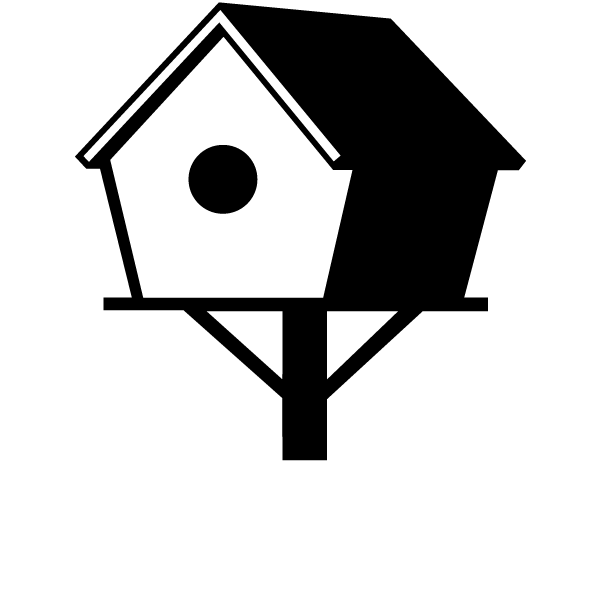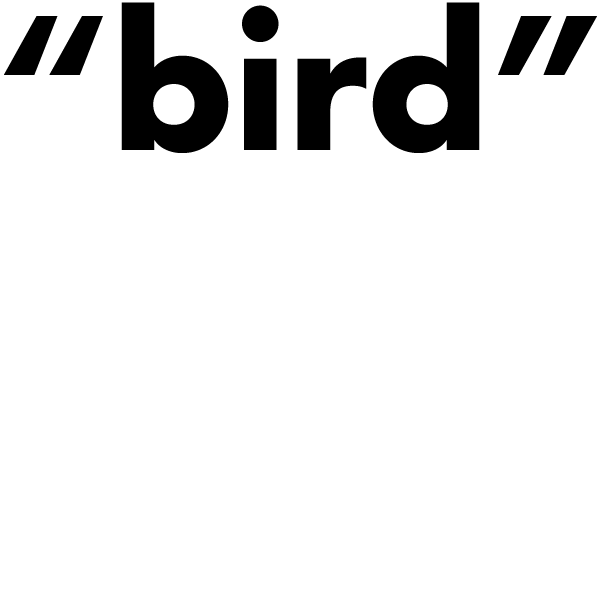Thesis Essay

In the exhibit "birdness," I examined the distinctions among Charles Sanders Peirce's semiotic definitions of icon, index, and symbol—modes of representation that, if used, provide designers a much deeper visual vocabulary. Understanding these key concepts of semiotics is significant for graphic designers, for these concepts provide the designer a more efficient way of employing ideas, concepts, methodologies and outcomes.
What didactic quality? Perhaps restate this sentence more simply, e.G., “How did i design my exhibit to introduce graphic designers to semiotics?” Birds. Consider real, living birds—not alfred hitchcock’s movie birds or the birdland jazz club or the english band the yardbirds. How do we recognize birds? We see them in flight. We see them perching on branches and telephone wires. We hear them chirping and singing. We hear the flapping of wings as a flock turns in the sky. We also recognize birds indirectly: a nest of twigs tucked into an evergreen shrub; a pile of feathers on the porch (evidence of a cat’s recent meal); and bird droppings on a car parked too long under a tree. In the two-dimensional realm of graphic communication, designers and artists have long employed birds not only for their most desirable trait, flight, but also for their rich history as cultural symbols, where birds have represented power, freedom, and divine spirit.
An icon, as defined by charles sanders peirce, closely resembles or imitates the signified—the original idea or image. This imitation is achieved through looking, feeling, sounding, smelling or tasting like that which is signified. The icon possesses some of the same qualities as the original. A prime example of iconicity is an illustration or a naturalist’s rendering of a bird, a mode of representation that requires a minimal amount of cognitive abilities to make the connection between signifier and signified. Artists heighten the markings and details of birds to convey their specific identities in the animal kingdom.
Just like a pointing index finger, the indexical mode of representation points to, or is physically or causally connected to, that which signifies or represents. The index is not an arbitrary link. Smoke points to or is evidence of a fire, just as a bullet hole points to the bullet or gun that made it. In design, indexicality is an enigmatic and creative mode of representing an idea or object. The singular feather is an index of that which is signified or referred to... A bird.

Symbols are by definition arbitrary or conventional. They depend upon a social agreement and are learned by the viewer. Perhaps the most well known system of symbols is our humble alphabet—collection of letterforms for constructing language visually. These letterforms possess no intrinsic connection to sounds of speech. It is a simple framework for communication. Other common examples of symbols are traffic signals or nautical flags. The dove commonly symbolizes peace.
Graphic designers manipulate meaning, create engaging experiences, and craft powerful messages using typography, imagery, form, color, motion, and sound. Graphic designers seek out and implement modes of representation and new ways of communicating. In doing so, designers engage in the study of semiotics.
To explore the connections between contemporary design practice and theories of semiotics, i use the bird as the illustrative example to present charles sanders peirce’s concepts of icon, index, and symbol. Design instructors often introduce undergraduates to semiotics with simplistic, two-dimensional examples on the printed page. One of the most common examples used to demonstrate various modes of representation is that of the bird: the word bird, an image of a bird, and an image of an egg or nest.
I worked through various ideas on how to best design a thesis project that was, at the core, didactic. I realized that in order to create an accessible entry point into what this lesson in semiotics was all about, the graphic design needed to take a second seat to the lesson at hand: visually explaining the differences and connections among icon, index, and symbol. I felt it best to illustrate these connections through a collection of related images and objects. Each object or image was placed strategically into the category in which it belonged most. For example, a photographic rendering of an actual bird was placed in the category of icon. An actual bird’s nest was placed into the index category. This system was the foundation for my thesis exhibit and visual research.
This strategy did seem to have an immediate disadvantage: this was a graphic design thesis and graphic design was now taking a backseat to pure and unaltered visual material. My hand, so to speak, was not as evident as it possibly should have been given the nature of this endeavor.
However, i believe that the curation of the images and objects is, in itself, an act of design. Design thinking is a cognitive act that requires as much skill as does building a web site or designing an identity. This exhibit was an exercise in design thinking through and through—from which objects were to be gathered to best illustrate a certain semiotic idea to how the entire exhibit was to unfold.
Integral to my project was the decision to tackle one lesson in semiotics. Rather than discuss the field of semiotics as a whole and how designers can utilize the breadth of these ideas, i chose to concentrate on charles sanders peirce’s concepts of icon, index, and symbol. These concepts are grounded in the lexicon of graphic design vernacular. Icons and symbols have been used throughout the course of design history, but even today it is often that the discerning designer confuses these modes of representation. This confusion often results in mixed messages or misinterpretation of the desired result. The indexical mode stands alone as perhaps the most challenging method of representation for it is the most demanding of cognitive activity. By focusing on just these three components of c.S. Peirce’s theory of semiotics, i have allowed for a more thorough examination of their differences and, in the end, an increased understanding of how these modes of representation can be applied to the practice of graphic design.
In my decision to isolate and explore the concepts of icon, index, and symbol it became apparent that the exclusion of other peircean ideas—particularly those of the representamen (the physical manifestation of an idea), object (the idea itself), and interpretant (our experience with the idea)—might be viewed as a major weakness in my research and final exhibit. The aforementioned concepts provide the reader/viewer with an even deeper understanding of the degrees of representation. They elucidate the nuances that exist between iconicity, indexicality, and symbolism. This is important in that the greater the arsenal of modes of representation, the more exceptional the resulting design has the opportunity to be.
However, the decision to exclude these tenets was made to ensure that my exhibit remained as didactic as possible without introducing elements of confusion; concepts that would detract from or complicate the lesson at hand—identifying the differences that exist between the icon, the index, and the symbol.
From the beginning, i set out to engage in a thesis project that would result in an educational lesson. My interest in semiotics lead me to a variety of paths that i could use to achieve this goal. I could have produced a series of booklets, one for each peircean concept that i ended up exploring. I could have chosen to build a website that visually outlined the the differences that exist between icon, index, and symbol. I could have also chosen to design and write a book that explores the faceted world of semiotics and its application in the realm of graphic design.
However, what i chose to do was something different. Something unexpected. to explore the connections between contemporary design practice and theories of semiotics, i use the bird as the illustrative example to present charles sanders peirce’s concepts of icon, index, and symbol.
The exhibit features many of the cultural and natural expressions—the signs—of birdness. This collection is a starting point. I will use the research i’ve gathered from this journey to continue my scholarly interest in semiotics, exploring where the world of semiotics fits within the realm of user experience and interaction design. How can the principles of semiotic theory help designers to enhance the experiences people are having and will continue to have online and off? I can only imagine the answers that this question might yield.